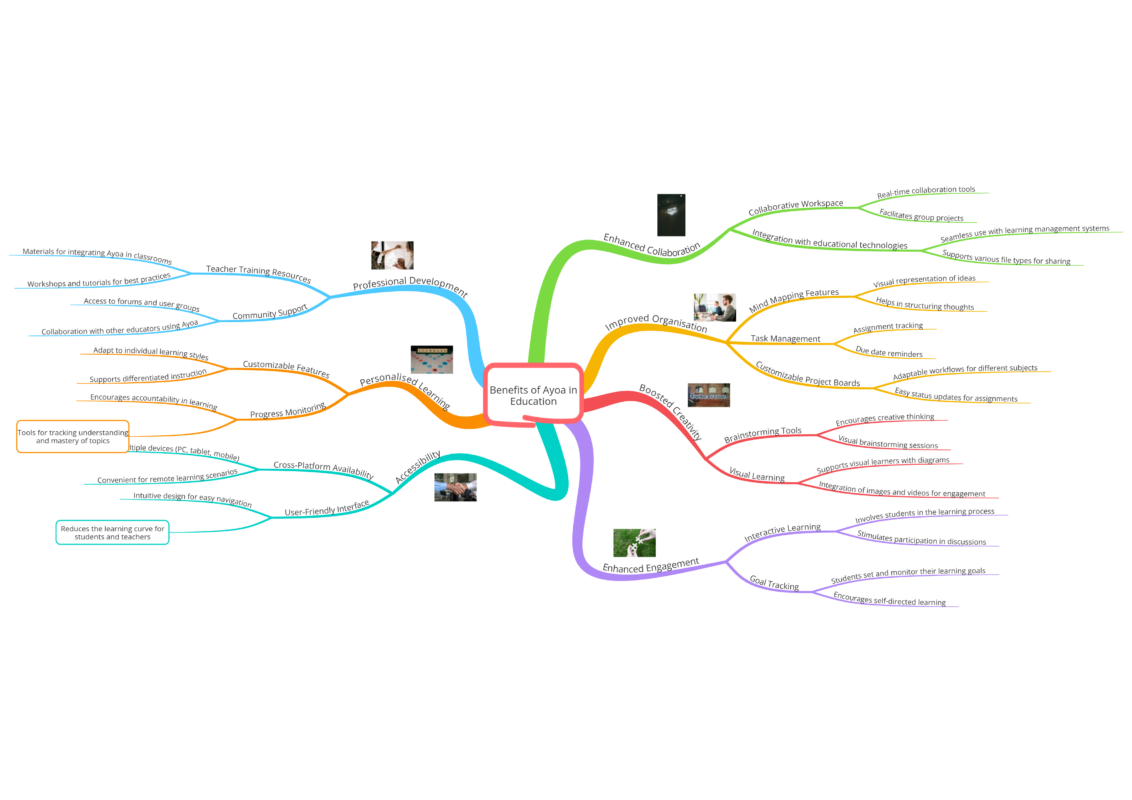Drawing from personal experience, Jay shows how mind mapping offers hope for neurodivergent students struggling with traditional education. This visual learning tool matches how our brains naturally work, boosting memory and organisation while transforming scattered thoughts into clear connections.
Rethinking Learning for Neurodivergent Students
I’m going to speak from experience.
Traditional education is built on a straightforward process. Listen to a lesson, take notes, memorise information, and then recall it in an exam. Simple, right? Not for everyone.
For neurodivergent people like me, that kind of rigid structure can feel impossible to keep up with. Dyslexic students might struggle with dense text.
ADHD learners might find it hard to stay focused long enough to capture key points. Those with executive function challenges may have a hundred great ideas but no clear way to organise them.
The problem isn’t intelligence, It’s how information is digested.
Most schools teach in a way that suits linear thinkers. Information is given in a set order, one step at a time, moving from A to B. But for many neurodivergent students, thinking doesn’t happen in a straight line. It’s more like a web, with ideas sparking off in different directions, connecting in unexpected ways. Trying to force those thoughts into traditional note-taking can feel like trying to shove a jigsaw puzzle into a straight line.
It just doesn’t fit.
This is where mind mapping comes in. I discovered mind mapping in 2017 when i was struggling to get through open University.
Mind mapping lets students see their thoughts instead of trying to hold them all in their head. It takes big ideas and breaks them into connected, visual branches. No rigid paragraphs, no endless bullet points, just a clear structure that makes sense to the person using it.
And here’s the interesting part. This isn’t just useful for neurodivergent students. When schools introduce neuroinclusive tools like mind mapping, everyone benefits. It gives all students a more flexible way to organise information, boosts creativity, and makes learning more engaging.
Maybe the issue isn’t neurodivergent students struggling to learn the “right way.” Maybe the system needs to rethink what the right way even is.
The Science Behind Mind Mapping
Ever tried cramming a long list of facts into your brain, only to forget half of them the next day? That’s because our brains don’t work like filing cabinets. We don’t store information in neat, linear lists. Instead, we create connections between ideas, linking them in ways that make sense to us.
This is exactly why mind mapping is so effective.
When we learn something new, our brain doesn’t just absorb it in isolation. It connects it to what we already know, creating a web of related concepts. This is called associative learning, and it’s why we remember things better when they are linked to something familiar.
Mind maps work because they reflect the way our brain naturally organises information.
Instead of being forced into rigid lists, ideas are spread out visually, making it easier to spot connections and see the bigger picture.
Here’s why this matters:
- You remember more. Studies have shown that mind mapping can enhance memory retention. For instance, research indicates that students using mind maps improved their long-term memory of factual information by 10% compared to traditional note-taking methods.
- It reduces cognitive overload. Breaking concepts into smaller, connected chunks makes them less overwhelming.
- It keeps you engaged. Creating a mind map is an active process. You are making connections as you go, rather than just copying notes.
For dyslexic learners, mind mapping removes the pressure of long-form writing. Instead of forcing thoughts into full sentences, they can see their ideas unfold in a way that feels more natural.
For ADHD brains, it provides a structured way to capture scattered thoughts without losing track of the bigger picture. It also helps reduce mental clutter, making it easier to focus on what matters.
For students with executive function challenges, mind mapping makes planning and organising much easier. It gives a clear overview of what needs to be done without feeling like an overwhelming list.
There’s plenty of research backing up why this approach works.
A study published in the Journal of Educational Psychology found that students who used mind mapping techniques remembered 10 to 15 percent more information compared to those using traditional note-taking.
The British Dyslexia Association highlights mind mapping as an effective tool for reducing processing strain and improving written composition for dyslexic students.In a classroom study, students using mind maps for exam revision reported feeling more confident and less stressed. Breaking topics into clear, visual sections helped them stay organised and recall key points more easily.
Mind mapping isn’t just a different way to take notes. It’s a tool that works with the way the brain naturally learns. When students use methods that suit how their brains process information, learning stops being a struggle and starts making sense.
Mind Mapping Tools Designed for All Learners
Not all mind mapping tools are the same. Some are as simple as a sketch on the back of a napkin. Others are digital, packed with features that help structure ideas, manage tasks, and even collaborate in real time.
Mind mapping is a concept that works in many different ways, and the most important thing is finding what fits each individual.
I first discovered mind mapping when I was struggling at university. Traditional note-taking wasn’t working for me. My thoughts didn’t flow in straight lines, and my notes were either too messy or too rigid. Mind mapping gave me a way to see my ideas instead of forcing them into a format that didn’t suit my brain.
 https://www.fenews.co.uk/wp-content/uploads/2025/02/benefits-of-ayoa-in-education-300x212.png 300w, https://www.fenews.co.uk/wp-content/uploads/2025/02/benefits-of-ayo... 768w, https://www.fenews.co.uk/wp-content/uploads/2025/02/benefits-of-ayo... 1536w, https://www.fenews.co.uk/wp-content/uploads/2025/02/benefits-of-ayo... 2048w, https://www.fenews.co.uk/wp-content/uploads/2025/02/benefits-of-ayo... 624w, https://www.fenews.co.uk/wp-content/uploads/2025/02/benefits-of-ayo... 600w" sizes="auto, (max-width: 1132px) 100vw, 1132px" />
https://www.fenews.co.uk/wp-content/uploads/2025/02/benefits-of-ayoa-in-education-300x212.png 300w, https://www.fenews.co.uk/wp-content/uploads/2025/02/benefits-of-ayo... 768w, https://www.fenews.co.uk/wp-content/uploads/2025/02/benefits-of-ayo... 1536w, https://www.fenews.co.uk/wp-content/uploads/2025/02/benefits-of-ayo... 2048w, https://www.fenews.co.uk/wp-content/uploads/2025/02/benefits-of-ayo... 624w, https://www.fenews.co.uk/wp-content/uploads/2025/02/benefits-of-ayo... 600w" sizes="auto, (max-width: 1132px) 100vw, 1132px" />Mind map Created in Ayoa
Why Mind Mapping Works for Neurodivergent Thinkers
Mind mapping is flexible, visual, and intuitive things that are crucial for neurodivergent learners.
In any form, it’s a game-changer for many people who struggle with traditional ways of learning. But digital tools take it to the next level by adding structure without limiting creativity.
At the end of the day, the best tool is the one that works for you, that might not be mind mapping and that’s ok.
What matters most is that people have access to learning methods that suit their brains.
The Broader Impact
Not every student struggles with learning, but plenty struggle with organising what they learn.
Take a history lesson on World War II. There are dates, key events, causes, and consequences—so much information to keep track of.
Mind mapping lays everything out visually, making it easier to see how different pieces fit together instead of getting lost in a sea of notes.
And it’s not just useful in school. Whether it’s planning a project, structuring an essay, or brainstorming creative ideas, having a clear visual overview makes everything feel more manageable.
One of the biggest challenges in learning is going from “I have an idea” to “I know what to do with it.” That’s especially true for students with executive function challenges. They might have amazing thoughts but struggle to structure them into something useful.
Mind mapping helps bridge that gap. By laying out thoughts visually, it becomes easier to plan essays, projects, or revision schedules.
What’s interesting is that when schools introduce tools designed to support Neuroinclusivity, they often realise those tools work for everyone.
Maybe the real issue isn’t that neurodivergent students struggle in a traditional system. Maybe the system was never built with them in mind. And maybe, by making education more flexible, we create a learning environment where more students can actually thrive.
The Future of Mind Mapping
The way we learn has never been one size fits all, so why is education still trying to make it that way?
Mind mapping helps students organise ideas, structure thoughts, and turn information into something meaningful. It’s particularly useful for neurodivergent learners, but the reality is, when schools introduce tools like this, everyone benefits.
By embracing more flexible, visual, and creative ways to learn, we’re not just making school easier for some students. We’re making learning better for everyone.
By Jay Williams, That Dyslexic Guy
 https://www.fenews.co.uk/wp-content/uploads/2025/01/Jay-Williams-Exclusive-300x200.jpg 300w,
https://www.fenews.co.uk/wp-content/uploads/2025/01/Jay-Williams-Exclusive-300x200.jpg 300w,
You need to be a member of THE VISUAL TEACHING NETWORK to add comments!
Join THE VISUAL TEACHING NETWORK